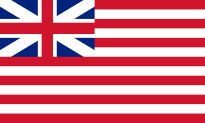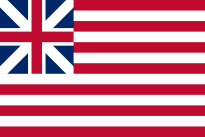We get “tie” from the Anglo Saxon “teag”, a bond or chain or tape.
The bond can be physical or spiritual or both, with “old school tie” a delicious example of the last.
While “tie” in the sense of a competitive outcome has been around since the 17th century, I can find no contemporary news report referring to the Electoral College vote of 3 December 1800 as a “tie” between Mr Jefferson and Mr Burr.
On 3 December 1775 the USS Alfred was commissioned as the first ship of the Continental Navy and John Paul Jones caused the Grand Union Flag to be hoisted upon the waters of the Delaware.
The peculiarity for today’s purposes is the presence on the occasion of two ties that bind.
First, the ship’s flag with its Union Jack canton. The similarity to the flag of the East India Company is striking. A recent scholar has referred to a remark from Benjamin Franklin to George Washington at a dinner:
While the field of your flag must be new in the details of its design, it need not be entirely new in its elements… there is already in use a flag… I refer to the flag of the East India Company.
The difficulty I have is that the conversation is said to have occurred ten days later, on 13 December.
Second, the ship’s name. The Alfred started life as merchant vessel, the Black Prince. One can understand the Continental navy removing the name of the son of an English monarch, not so much replacing it with the name of another English monarch. I suspect it was because Alfred has until fairly recent times been regarded as the founder of the English navy.
After more than two centuries, the conventional narrative of the revolution is an adult son breaking ties with a tyrannical father. 3 December 1775 is a reminder that many involved with the process saw themselves as cousins with the English and not their children. Almost 200 years later that India of the East India Company became at once free of England and the first republican member of the Commonwealth. A few rereadings of those East India Company tealeaves dumped in Boston Harbour and US history may have unfolded just a little differently than it did.

